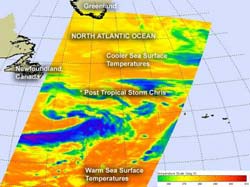NASA sees first Atlantic hurricane fizzling in cool waters

NASA's Aqua satellite passed over Post-Tropical Storm Chris on June 22 at 12:47 a.m. EDT. The infrared data from the AIRS instrument onboard Aqua indicated the storm is in waters that are too cool to maintain its strength. The waters are near 290 Kelvin (62F/16.8C). Credit: NASA/JPL, Ed Olsen<br>
Sea surface temperatures play a big role in keeping a tropical cyclone alive. They need warm seas of at least 300 Kelvin (80 Fahrenheit/26.8 Celsius) to maintain strength. NASA's Aqua satellite revealed that those conditions were not met where Chris is located in the Atlantic Ocean.
When NASA's Aqua satellite passed over Chris at 0447 UTC (12:47 a.m. EDT) today, June 22, the Atmospheric Infrared Sounder (AIRS) instrument captured a new infrared image of Chris' clouds and surrounding sea surface temperatures. The sea surface temperatures to the south of Chris are at least 300 Kelvin (80 Fahrenheit/26.8 Celsius) and warmer. In the area where Chris is located, AIRS revealed that sea surface temperatures are closer to 290 Kelvin (62 Fahrenheit/16.8 Celsius).
At 11 a.m. EDT on June 22, Chris was now classified as a post-tropical storm with maximum sustained winds near 45 mph (75 kmh). Chris was far to the north near 44.6 North and 46.9 West, about 335 miles (535 km) east-southeast of Cape Race, Newfoundland, Canada. Chris was moving to the west-southwest near 16 mph (kmh), and is expected to slow and turn southward. Chris' minimum central pressure is 990 millibars.
According to the National Hurricane Center, Chris “should merge with another extratropical low on Saturday [June 23]” in the north Atlantic Ocean.
Media Contact
More Information:
http://www.nasa.govAll latest news from the category: Earth Sciences
Earth Sciences (also referred to as Geosciences), which deals with basic issues surrounding our planet, plays a vital role in the area of energy and raw materials supply.
Earth Sciences comprises subjects such as geology, geography, geological informatics, paleontology, mineralogy, petrography, crystallography, geophysics, geodesy, glaciology, cartography, photogrammetry, meteorology and seismology, early-warning systems, earthquake research and polar research.
Newest articles

High-energy-density aqueous battery based on halogen multi-electron transfer
Traditional non-aqueous lithium-ion batteries have a high energy density, but their safety is compromised due to the flammable organic electrolytes they utilize. Aqueous batteries use water as the solvent for…

First-ever combined heart pump and pig kidney transplant
…gives new hope to patient with terminal illness. Surgeons at NYU Langone Health performed the first-ever combined mechanical heart pump and gene-edited pig kidney transplant surgery in a 54-year-old woman…

Biophysics: Testing how well biomarkers work
LMU researchers have developed a method to determine how reliably target proteins can be labeled using super-resolution fluorescence microscopy. Modern microscopy techniques make it possible to examine the inner workings…





















